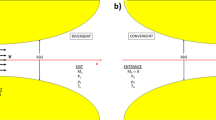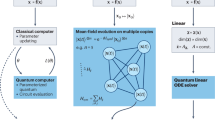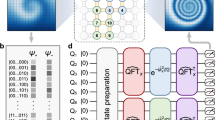Abstract
Constraints in power consumption and computational power limit the skill of operational numerical weather prediction by classical computing methods. Quantum computing could potentially address both of these challenges. Herein, we present one method to perform fluid dynamics calculations that takes advantage of quantum computing. This hybrid quantum–classical method, which combines several algorithms, scales logarithmically with the dimension of the vector space and quadratically with the number of nonzero terms in the linear combination of unitary operators that specifies the linear operator describing the system of interest. As a demonstration, we apply our method to solve the advection–diffusion equation for a small system using IBM quantum computers. We find that reliable solutions of the equation can be obtained on even the noisy quantum computers available today. This and other methods that exploit quantum computers could replace some of our traditional methods in numerical weather prediction as quantum hardware continues to improve.





Similar content being viewed by others
References
J. T. Oden, T. Belytschko, J. Fish, T. J.R. Hughes, C. Johnshon, D. Keyes, A. Laub, L. Petzold, D. Srolovitz, S. Yip and J. Bass, "Report of the National Science Foundation Blue Ribbon Panel on Simulation-Based Engineering Science," (2006)
Bauer, P., Thorpe, A., Brunet, G.: The quiet revolution of numerical weather prediction. Nature 525, 47–55 (2015)
R. Loft, "Earth System Modeling Must Become More Energy Efficient," Eos, 28 (2020)
Arute, F., Arya, K., Babbush, R., Bacon, D., Bardin, J.C., Barends, R., Biswas, R., Boixo, S., Brandao, F.G.S.L., Buell, D.A.: Quantum supremacy using a programmable superconducting processor. Nature 574, 505–510 (2019)
C. Berger, A. Di Paolo, T. Forrest, S. Hadfield, N. Sawaya, M. Stęchły and K. Thibault, "Quantum technologies for climate change: Preliminary assessment," arXiv preprint arXiv:2107.05362, (2021)
J. Preskill, "Quantum computing 40 years later," arXiv preprint arXiv:2106.10522, (2021)
E. Pednault, J. Gunnels, D. Maslov and J. Gambetta, "On quantum supremacy," IBM Research Blog, vol. 21, (2019)
Schaller, R.R.: Moore’s law: past, present and future. IEEE Spectr. 34, 52–59 (1997)
Burg, D., Ausubel, J.H.: Moore’s Law revisited through Intel chip density. PLoS ONE 16, e0256245 (2021)
Schultz, M.G., Betancourt, C., Gong, B., Kleinert, F., Langguth, M., Leufen, L.H., Mozaffari, A., Stadtler, S.: Can deep learning beat numerical weather prediction? Phil. Trans. R. Soc. A 379, 20200097 (2021)
Weyn, J.A., Durran, D.R., Caruana, R.: Can machines learn to predict weather? Using deep learning to predict gridded 500-hPa geopotential height from historical weather data. J. Adv. Model. Earth Syst. 11, 2680–2693 (2019)
J. A. Weyn, D. R. Durran and R. Caruana, "Improving data-driven global weather prediction using deep convolutional neural networks on a cubed sphere," Journal of Advances in Modeling Earth Systems, vol. 12, p. e2020MS002109, (2020)
"Clay Math Institute," [Online]. Available: http://www.claymath.org/millennium-problems/navier%E2%80%93stokes-equation.
F. Gaitan, "Finding flows of a Navier–Stokes fluid through quantum computing," Quantum Information Processing , vol. 6, no. 1, (2020)
F. Oz, R. K. S. S. Vuppala, K. Kara and F. Gaitan, "Solving Burgers' equation with quantum computing," Quantum Information Processing, vol. 21, no. 1, (2022)
P. Garcı́a-Molina, J. Rodrı́guez-Mediavilla and J. J. Garcı́a-Ripoll, "Solving partial differential equations in quantum computers," arXiv preprint arXiv:2104.02668, 2021.
Engel, A., Smith, G., Parker, S.E.: Linear embedding of nonlinear dynamical systems and prospects for efficient quantum algorithms. Phys. Plasmas 28, 062305 (2021)
W. Itani, "Fluid Dynamicists Need to Add Quantum Mechanics into their Toolbox," (2021)
Berry, D.W.: High-order quantum algorithm for solving linear differential equations. J. Phys. A: Math. Theor. 47, 105301 (2014)
Berry, D.W., Childs, A.M., Ostrander, A., Wang, G.: Quantum algorithm for linear differential equations with exponentially improved dependence on precision. Commun. Math. Phys. 356, 1057–1081 (2017)
Xin, T., Wei, S., Cui, J., Xiao, J., Arrazola, I., Lamata, L., Kong, X., Lu, D., Solano, E., Long, G.: Quantum algorithm for solving linear differential equations: theory and experiment. Phys. Rev. A 101, 032307 (2020)
J.-P. Liu, H. Ø. Kolden, H. K. Krovi, N. F. Loureiro, K. Trivisa and A. M. Childs, "Efficient quantum algorithm for dissipative nonlinear differential equations," Proceed. National Acad. Sci., vol. 118, (2021)
Suau, A., Staffelbach, G., Calandra, H.: Practical Quantum Computing: solving the wave equation using a quantum approach. ACM Trans. Quantum Comput. 2, 1–35 (2021)
Arrazola, J.M., Kalajdzievski, T., Weedbrook, C., Lloyd, S.: Quantum algorithm for nonhomogeneous linear partial differential equations. Phys. Rev. A 100, 032306 (2019)
S. K. Leyton and T. J. Osborne, "A quantum algorithm to solve nonlinear differential equations," arXiv preprint arXiv:0812.4423, (2008)
Childs, A.M., Liu, J.-P.: Quantum spectral methods for differential equations. Commun. Math. Phys. 375, 1427–1457 (2020)
A. M. Childs, J.-P. Liu and A. Ostrander, "High-precision quantum algorithms for partial differential equations," arXiv preprint arXiv:2002.07868, (2020)
Costa, P.C.S., Jordan, S., Ostrander, A.: Quantum algorithm for simulating the wave equation. Phys. Rev. A 99, 012323 (2019)
S. Lloyd, G. De Palma, C. Gokler, B. Kiani, Z.-W. Liu, M. Marvian, F. Tennie and T. Palmer, "Quantum algorithm for nonlinear differential equations," arXiv preprint arXiv:2011.06571, (2020)
Kyriienko, O., Paine, A.E., Elfving, V.E.: Solving nonlinear differential equations with differentiable quantum circuits. Phys. Rev. A 103, 052416 (2021)
Childs, A.M., Kothari, R., Somma, R.D.: Quantum algorithm for systems of linear equations with exponentially improved dependence on precision. SIAM J. Comput. 46, 1920–1950 (2017)
Lubasch, M., Joo, J., Moinier, P., Kiffner, M., Jaksch, D.: "Variational quantum algorithms for nonlinear problems," Physical Review A, 101, p. 010301 (2020)
Gourianov, N., Lubasch, M., Dolgov, S.: "A quantum-inspired approach to exploit turbulence structure," Nat Comput Sci, 2, p. 30–37 (2022). https://doi.org/10.1038/s43588-021-00181-1
Budinski, L.: "Quantum algorithm for the advection–diffusion equation simulated with the lattice Boltzmann method," Quantum Inf Process, 20, p. 57 (2021). https://doi.org/10.1007/s11128-021-02996-3
Budinski, L.: "Quantum algorithm for the Navier–Stokes equations by using the streamfunction-vorticity formulation and the lattice Boltzmann method," International Journal of Quantum Information, 20, p. 2150039 (2022). https://doi.org/10.1142/S0219749921500398
Peruzzo, A., McClean, J., Shadbolt, P., Yung, M.-H., Zhou, X.-Q., Love, P.J., Aspuru-Guzik, A., O’brien, J.L.: A variational eigenvalue solver on a photonic quantum processor. Nature Commun. 5, 1–7 (2014)
J. Gambetta, I. Faro and K. Wehden, "IBM’s roadmap for building an open quantum software ecosystem," IBM, 4 (2021)
D. Gunlycke, M. C. Palenik, A. R. Emmert and S. A. Fischer, "Efficient algorithm for generating Pauli coordinates for an arbitrary linear operator," arXiv preprint arXiv:2011.08942, (2020)
C. Bravo-Prieto, R. LaRose, M. Cerezo, Y. Subasi, L. Cincio and P. J. Coles, "Variational quantum linear solver," arXiv preprint arXiv:1909.05820, (2019)
Andrea, "Pennylane," 20 January 2021. [Online]. Available: https://pennylane.ai/qml/demos/tutorial_vqls.html.
"IBM Quantum," 2021. [Online]. Available: https://quantum-computing.ibm.com/.
Cerezo, M., Sone, A., Volkoff, T., Cincio, L., Coles, P.J.: Cost function dependent barren plateaus in shallow parametrized quantum circuits. Nat. Commun. 12, 1–12 (2021)
Sim, S., Johnson, P.D., Aspuru-Guzik, A.: Expressibility and entangling capability of parameterized quantum circuits for hybrid quantum-classical algorithms. Adv. Quantum Technol. 2, 1900070 (2019)
Spall, J.C.: An overview of the simultaneous perturbation method for efficient optimization. J. Hopkins APL Tech. Dig. 19, 482–492 (1998)
Spall, J.C.: Implementation of the simultaneous perturbation algorithm for stochastic optimization. IEEE Trans. Aerosp. Electron. Syst. 34, 817–823 (1998)
Cross, A.W., Bishop, L.S., Sheldon, S., Nation, P.D., Gambetta, J.M.: Validating quantum computers using randomized model circuits. Phys. Rev. A 100, 032328 (2019)
Acknowledgements
RD, DG, CAR, and JDD has been supported by the Office of Naval Research (ONR) through the NRL Base Program, PE 0601153N. We acknowledge quantum computing resources from IBM through a collaboration with the Air Force Research Laboratory (AFRL).
Author information
Authors and Affiliations
Corresponding author
Ethics declarations
Conflict of interest
The authors declare that they have no conflict of interest.
Data availability statement
Due to confidentiality agreements, supporting data can only be made available to bona fide researchers subject to a non-disclosure agreement. Details of the data and how to request access are available from Reuben Demirdjian at the U.S. Naval Research Laboratory.
Additional information
Publisher's Note
Springer Nature remains neutral with regard to jurisdictional claims in published maps and institutional affiliations.
Supplementary Information
Below is the link to the electronic supplementary material.
Rights and permissions
Springer Nature or its licensor holds exclusive rights to this article under a publishing agreement with the author(s) or other rightsholder(s); author self-archiving of the accepted manuscript version of this article is solely governed by the terms of such publishing agreement and applicable law.
About this article
Cite this article
Demirdjian, R., Gunlycke, D., Reynolds, C.A. et al. Variational quantum solutions to the advection–diffusion equation for applications in fluid dynamics. Quantum Inf Process 21, 322 (2022). https://doi.org/10.1007/s11128-022-03667-7
Received:
Accepted:
Published:
DOI: https://doi.org/10.1007/s11128-022-03667-7




